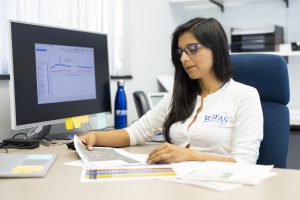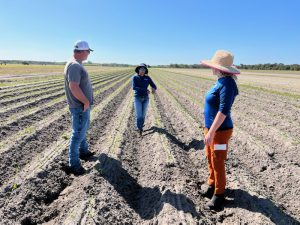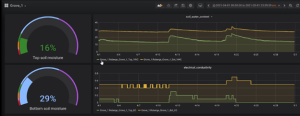The Power of Machine Learning
Today, agricultural engineering includes the wide range of technologies and disciplines that must be employed to meet the challenges of a new century. A hundred years ago, agricultural engineers were developing and refining the machines and mechanical methods that would transform agriculture in the 20th century. Machines are still central to agriculture, but many ag engineers now focus on machine learning and other artificial intelligence methods that will transform agriculture in the 21st century. With these and many other tools, ag engineers are helping producers adapt agricultural practice to a world confronting an ever-increasing population and its food needs in a context of climate change and environmental stewardship.
Machine learning is a type of artificial intelligence software capable of helping to understand complex situations that involve many factors at the same time. Machine learning algorithms examine data and extract patterns. The operator provides input that guides the software in seeking patterns in the data, but the software itself gets better as it checks more data – it learns. It’s a powerful technique, and it has been used in many applications, including image and facial recognition, translation, medical diagnosis, traffic patterns, and a host of others.
Applying AI and Machine Learning to Irrigation

Dr. Sandra Guzmán specializes in applying solutions that include artificial intelligence and machine learning to irrigation and hydrology problems in agriculture. Guzmán is an assistant professor at the Indian River Research and Education Center (IRREC), where she leads the Smart Irrigation and Hydrology program. The Indian River district and nearby coastal counties form one of the most important citrus-producing areas of Florida. In addition to her research in the smart irrigation and hydrology lab at IRREC, Guzmán works directly with citrus producers to manage water more effectively, helping save a valuable resource and money while they increase productivity.
With new technology coming at us all the time, producers may not be clear on how to incorporate new high-tech methods. Smart irrigation systems built on irrigation apps and soil moisture sensors have already found their place in Florida agriculture. Producers that use them can see how they make a difference in applying water more precisely, which reduces water use and improves plant health. But there was a time when even this technology was new and unproven on a production scale and required an investment of time and money. It can take a season or two to see if the investment is worth it. But time after time, the technology has demonstrated its value.

Similarly, at this point, artificial intelligence and machine learning might seem like a step too far. This is where the relationship between the producers and the IFAS Extension Service comes in. That relationship has been forged during more than a century of Extension support and innovation that has helped producers grow and compete successfully. Guzmán brings that credibility in her visits with producers in the form of a friendly face and expert knowledge. She can help producers get past the new-tech jitters and explain how machine learning can be a powerful addition to irrigation practices that producers have become familiar with.
Guzmán and her team find a very mixed picture in the Indian River area and other agricultural areas where they work in Florida. Some producers are not yet using smart irrigation, while others have systems that are not up to date with the latest sensors. Up-to-date sensors that can collect and communicate moisture data provide the essential input for Guzmán’s machine learning software. The software can produce a variety of information for producers that can guide their irrigation practices and help ensure the health of their trees.
Guzmán explains that in Florida, we have two “water seasons”: one when we are getting too little water and one when we are getting too much. Either situation stresses plants and reduces productivity. Smart irrigation helps the producer even out the water that crops are receiving to help maintain optimum plant condition.
Guzmán can work with producers to get them started with smart irrigation or to help them create the system they need to control irrigation and to generate the data needed for the advanced tools she can provide. Guzmán knows this is not always easy for producers, so her team focuses on ease of use; in fact, her team has a slogan: “If it’s easy; it’s useful.”
Addressing the Global Water Challenge
Guzmán is one of many IFAS faculty working on different aspects of citrus and specialty crops such as disease resistance and grove management to begin to reverse the damage done to the industry by huanglongbing, also called citrus greening, and other pests. As part of this effort, the Guzmán lab developed a water management tool called IrrigMonitor. This decision support system software “combines data from different types and brands of in-field sensors, including soil moisture and weather sensors for the assessment of the water status of the orchard.” The software allows the grower to quickly assess the water status of the top soil layers where most plant roots are located. This can guide the grower to irrigate more frequently at lower volumes, which has been found to reduce stress in trees affected by huanglongbing. IrrigMonitor’s visual displays also advise growers about excess water applied, nutrients being lost, or water table rise.

With work of this kind, Guzmán helps to address what is expected to be one of the greatest challenges of the 21st century: water. The United Nations has said that water consumption is growing at twice the rate of population growth. In many areas of the world, this is likely to lead to unsustainable communities and can produce political instability and conflict. As individuals, we might only see water issues when water restrictions are announced, but specialists like Guzmán work hard to see and understand the big picture and make that information useful to others, with important implications both for groves and for countries.
That’s UF ABE: Big Questions, Global Reach.
This article was written by: Charles Brown
Source: UF/IFAS Pest Alert
Note: All images and contents are the property of UF/IFAS.





